PureInsight | December 3, 2023
[PureInsight.org]
Sudan: Meroë Small Pyramids
227 kilometers north of the Sudanese capital Khartoum, amidst golden sand dunes, there is a cluster of small pyramids known as the Meroë pyramids. These were built by pharaohs of the Kushite kingdom between the 7th and 3rd centuries BCE. They were only discovered by Western archaeologists in the late 19th century.
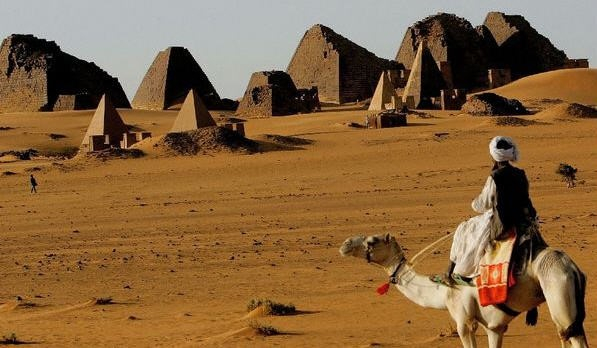
According to historical records, around 1000 BC, with the decline of the Egyptian kingdom, the Sudanese kingdom of Kush, located in the middle of the Nile, unified the Nile Valley and established a powerful Kushite empire from 712 to 657 BC. In the early period, it was constantly invaded by the Egyptian army, and Egyptian civilization had already been introduced. After 22 years of establishing the kingdom, Kush conquered Egypt and established Memphis as its capital, known as the 25th dynasty of Egypt. At this time, Sudan and Egypt were both part of the Kushite empire, which was the most glorious period in Sudanese history. In 590 BC, the capital was moved to Merowe, and it remained there until AD 350 when it was eventually conquered by other countries due to internal strife.
Throughout this over 1000-year history, Merowe has always been the largest city, the religious center, the location of the royal palace, and the site of funerary rituals. On two sand ridges outside the city, 224 Sudanese pyramids from different periods were also constructed, making it a witness to the history of the ancient Sudanese kingdom of Kush and its Napatan culture (from 900 BC to 270 BC) and Meroitic culture (from 270 BC to 350 AD). However, by the 4th century AD, Merowe gradually declined, and the small pyramids were left unexamined.
The materials used for the construction of the Egyptian pyramids were mostly mud bricks, basalt, and granite. As Sudan does not produce granite, the Sudanese small pyramids were built with polished sandstone and mudstone found nearby, and filled with sand and crushed stone on the inside.
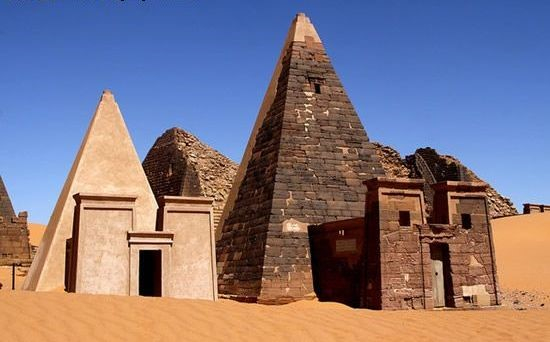
These small and steep pyramids, the largest of which are about 20-30 meters high, are located very close to each other, with some pyramid bases almost connected. Unlike Egyptian pyramids, their shape is steep and the protruding part of the pyramid base has an arch and a passage. Most of the pyramids still have shrines in front of them, but few are intact and some only have a circle of wall foundations left. The size and height of these shrines vary, but their specifications are generally the same. They are symmetrical rectangular buildings modeled after Egyptian temples, with a large gate in the middle and large reliefs on the walls on both sides.
Over the course of more than two thousand years, the small pyramids in Sudan have suffered significant weathering and partial collapse, making it difficult to see their full appearance. On the remaining foundations of some of the temples, inscriptions and inscribed texts in the Nubian script can still be seen. By 200 BC, the people of Meroë had developed their own Nubian script, which was similar to ancient Egyptian writing and clearly influenced by the Egyptian language. Despite over 50 years of study, experts have only been able to decipher the phonetic sounds and names of 23 letter symbols, making it difficult to decode their grammar and vocabulary and understand their contents.
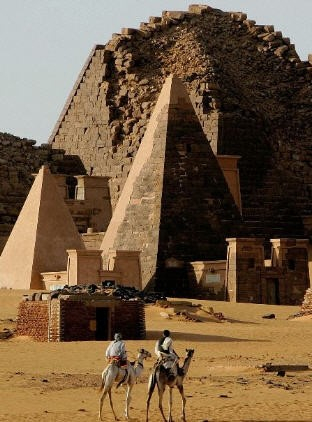
224 small pyramids buried the history of the Kingdom of Kush, Napata, and the Meroë era. The large temperature difference between day and night, strong winds, and flying sand threaten these 2000-year-old relics almost constantly, and human destruction has not ceased either. In the 19th century, there was a craze for tomb raiding, and almost all the Meroë pyramids were looted. In particular, the Italian explorer Giuseppe Ferlini (1800-1870), who was only looking for gold, crazily dug up 40 small pyramids in the 1820s, which was most painful for the Sudanese people.
The Egyptian Pyramids
On November 11, 2008, the 118th pyramid (with an estimated total of 137) was discovered in Egypt. Among these pyramids, the most well-known and largest, and in the best condition, are the "Giza Pyramids" in the outskirts of Cairo. They are a group of pyramids, with the three largest being the most famous: the Khufu Pyramid, the Khafra Pyramid, and the Menkaure Pyramid.
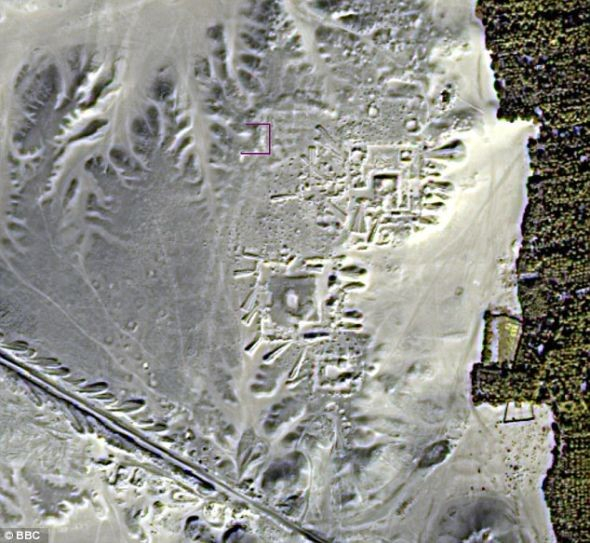
Infrared imaging detected 17 previously undiscovered underground pyramids in Egypt.
In 2011, it was reported that a laboratory at the University of Alabama in Birmingham, USA, had used satellite infrared imaging technology to detect 17 previously undiscovered underground pyramids in Egypt, as well as over 1000 unexcavated tombs and over 3000 ancient house sites. This was considered a major discovery in space archaeology.
The report states that ancient Egyptians used mud bricks to construct houses, which have a higher density than other materials and can be detected by satellites even from 700 kilometers away from Earth. In addition, with infrared technology, objects less than one meter in diameter on Earth can be displayed accurately on the screen.
Based on satellite images, the team excavated a 3,000-year-old residential structure whose outline was almost identical to that shown in the satellite image, providing strong evidence for the reliability of the technology.
Abu Rawash Pyramid
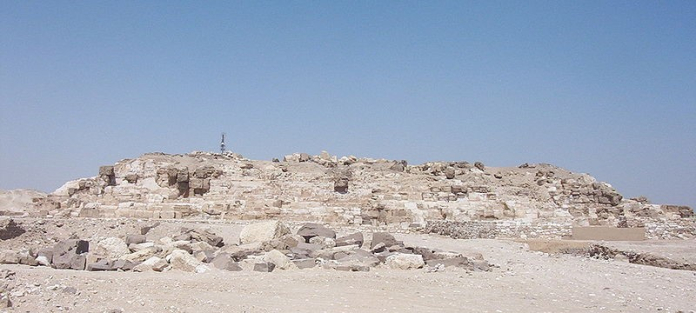
The Abu Rawash pyramid ruins are one of the northernmost pyramids in Egypt and the sixth largest pyramid in Egypt, according to Lepsius' research. It was the tomb of Pharaoh Khufu's son and successor, and was originally similar in size to the Menkaure pyramid.
Unfortunately, during the ancient Roman era in Europe, it was used as a source of stone for other buildings, and was mined and destroyed, leaving only the core of the pyramid consisting of stacked stone roads and piles of stones. There is also a better-preserved satellite pyramid nearby.
The Abu Sir Pyramid Complex
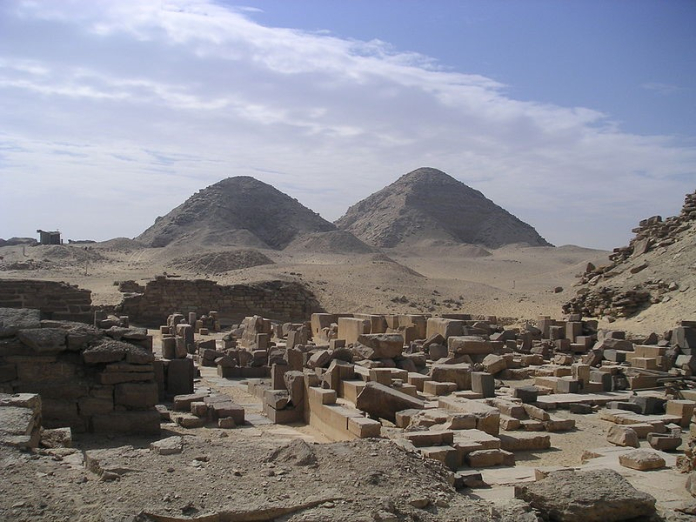
Abusir has a total of 57 pyramids and was used as a royal necropolis during the Fourth and Fifth Dynasties. In Abusir, the architectural quality and technology of the Fifth Dynasty pyramids are noticeably inferior to those of the Fourth Dynasty. The materials used in construction were also of lower quality local limestone.
All the pyramids in Abusir were built as step pyramids. The largest pyramid is the Pyramid of Neferirkare Kakai, which was originally built as a step pyramid approximately 70 meters high. Later, the missing corners of the steps were filled with loose stone to create a "true pyramid," which also had a smooth surface.
The main pyramids here are the Pyramids of Nyuserre, Neferirkare, and Sahure, among which the Pyramid of Nyuserre is the most intact. This is also the location of the Pyramid of Raneferef, a pharaoh of the Fifth Dynasty of ancient Egypt.
Meidum Pyramid
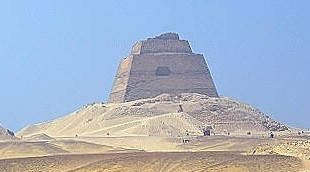
One of the Meidum pyramids is the pyramid of Sneferu (the founder of the ancient Egyptian Fourth Dynasty).
The outer pyramid casing of the Meidum pyramid suffered severe collapses in ancient times, and now only the inner core structure remains standing, surrounded by the collapsed outer casing and sandstones. This makes it a peculiar-looking pyramid ruin, and the mound underneath it is not natural. In fact, this heap of debris was formed when the outer casing collapsed.
The Pyramid of Hawara

Hawara has one of the pyramids belonging to Amenemhat III, the last powerful pharaoh of the twelfth dynasty, located near the Fayum Oasis. It is generally believed to have been built by him, along with the Black Pyramid in the Dahshur pyramid complex, and the pyramid in Hawara was his final resting place.
Pyramid of Lahun

El-Lahun has a pyramid of Senusret II, the southernmost royal pyramid in Egypt. The architect cleverly used a 12-meter high natural limestone mountain as the core of the building base, greatly reducing the work required during construction.
Step Pyramid
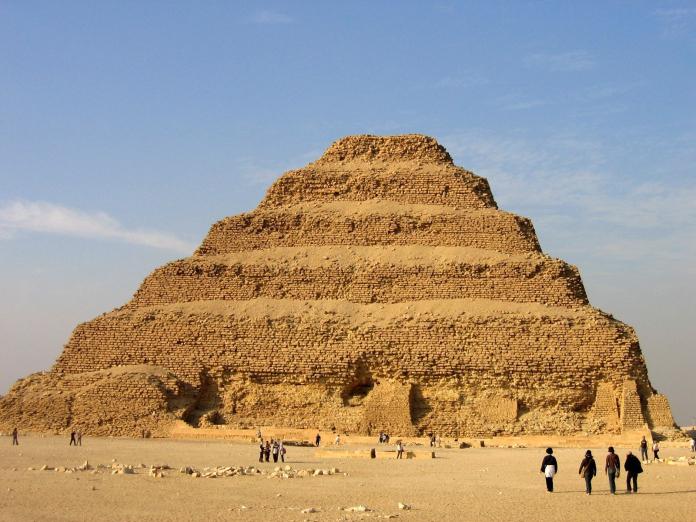
The three great pyramids in Giza are not the oldest pyramids in Egypt, the oldest one dates back to the "Step Pyramid" in Saqqara.
The Step Pyramid was built during the reign of King Djoser of the Third Dynasty (2630 - 2611 BC), it is 62 meters high and has six layers. It was originally a simple mastaba tomb, but later, more layers were added to create the current structure. It was not until the Fourth Dynasty of Egypt, a century later, that the construction of pyramid-shaped tombs began and continued until the last pyramid was built during the 18th Dynasty of Egypt in the 17th century BC.
Before the third dynasty of Ancient Egypt, massive rectangular mounds made of mud bricks were commonly used as tombs. During the third dynasty, under the leadership of Imhotep, the chief minister and high priest of Pharaoh Djoser, a special method was used to construct the pharaoh's tomb. Imhotep designed and constructed the first large-scale stone building in human history. Although the building technology was not yet perfect, small stones were used to fill gaps, and sawdust and gravel were used to fill joints to compensate for the shortcomings of the technology.
He first used stones to build a rectangular tomb mound about 8 meters high and 63 meters long. Later, he constantly changed his plans and designed the tomb to be built in a step-like structure, with each layer becoming smaller than the previous one. Six "Mastabas" with rectangular flat tops and sloping outer faces were built on top of each other, until the sixth layer was reached. Afterwards, this massive structure was covered with exquisite white limestone. When completed, the tomb mound was 62 meters high, with a length of about 121 meters from east to west and about 109 meters from north to south, making it Egypt's earliest six-level step pyramid. King Djoser was buried in a burial chamber located 28 meters deep underneath the pyramid.
The "Step Pyramid" is not just the pyramid itself, but a complex of buildings surrounded by a wall. The entire complex has an area of 544 meters north-south and 277 meters east-west, with a limestone wall around it that is 10 meters high. The southeast corner of the wall is the entrance to the entire complex, which includes 14 false doors and 40 columns. It also includes a large central courtyard in front, where King Djoser had to hold bullfights every year.
The surviving statue of Djoser in the Cairo Museum is one of the larger life-size stone sculptures in Egyptian carving history. It represents the majestic symbol of the pharaoh. The hieroglyphs on the base of the statue are unprecedentedly carved with a name other than the pharaoh's own name, namely "Imhotep". Imhotep, the chief priest of Djoser, played an indispensable role in the construction of Djoser's first pyramid, so his name was inscribed on the base of the pharaoh's statue.
Imhotep's construction of the Step Pyramid was a historic achievement that elevated him from a "man" to a "god" in the eyes of the Egyptian people.
The Red Pyramid, Bent Pyramid
Dahshur is located at the southern end of Saqqara, the birthplace of the pyramids. The true pyramids first appeared during the reign of Pharaoh Huni of the 3rd Dynasty. Huni began building a pyramid in Meidum, but due to insufficient technology, it was not successful and only the skeleton remains, which is not open to visitors.
The Bent Pyramid was created as a result of a new architectural approach that emerged after the construction of the Step Pyramid. After the completion of the Step Pyramid, there was an important transitional period. The remnants of the Meidum Pyramid, which has a two-step structure, attempted to fill the gaps between the steps with stones to create a pyramid with a smooth surface. This new way of thinking about architecture led to the creation of the Bent Pyramid.
Bent Pyramid
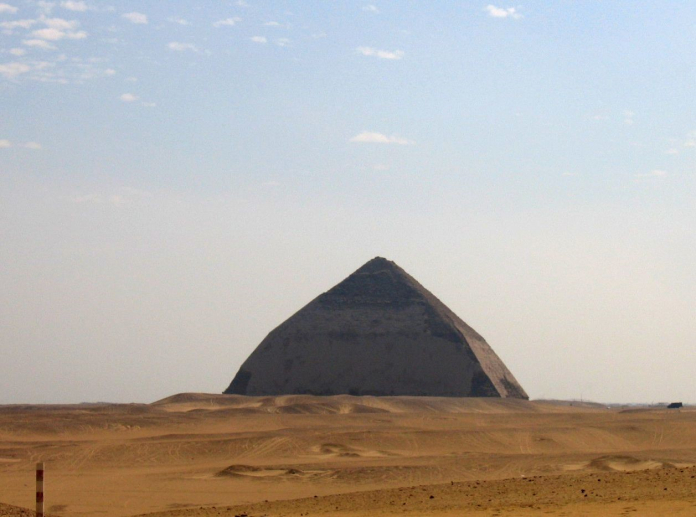
During the reign of Snefru, the first pharaoh of the Fourth Dynasty of Egypt, a bent pyramid was constructed in 2600 BC. It has a square base with sides measuring approximately 189 meters and a height of around 105 meters.
Pharaoh Snefru did not like the step-style pyramid, so he built a second pyramid that extended upward at an angle of 55 degrees. When the pyramid was more than halfway completed, they discovered that it might collapse, so they changed the angle to a curved slope of 43.5 degrees. As the pyramid looks curved from all four sides, it is called the "bent pyramid".
It is one of the few pyramids with a smooth surface that still exists, and it was opened to visitors on March 16, 2009.
Red Pyramid
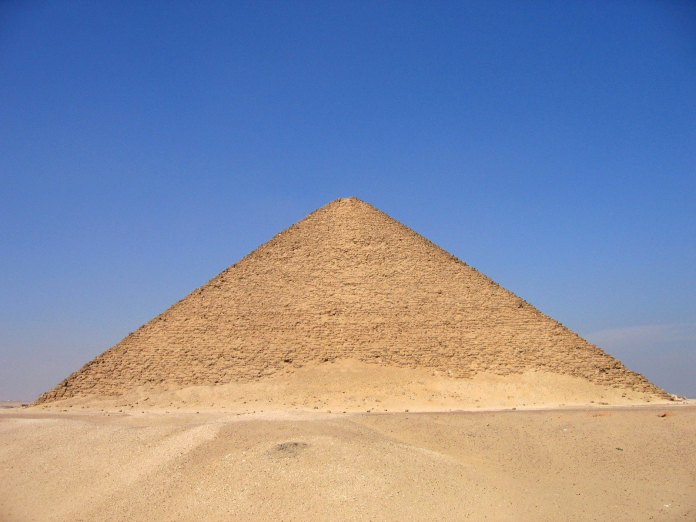
The Red Pyramid is the result of learning from past failures and striving for better. After the completion of the Bent Pyramid, Pharaoh Sneferu was not satisfied and immediately built the first true pyramid in the north - the Red Pyramid. It is the oldest and truest pyramid in Egypt and is about the same size as the Great Pyramid of Giza, with a height of about 104.5 meters and a base length of about 220 meters.
This pyramid stands perfectly in the desert, with an inclination of 43 degrees, second only to the Great Pyramid of Khufu in height. It is called the Red Pyramid because it was constructed using red limestone, which gives it a pale red color, but its original name was the "Shining Pyramid."
To this day, two pyramids still stand in Dahshur, with the Red Pyramid in particular being well-preserved. The internal chambers supported by load-bearing blocks remain undamaged. In just 60 years, Pharaoh Snefru completed the challenge of transitioning from a step pyramid to a true pyramid with a triangular base. This achievement demonstrates his strong ambition, confidence, and remarkable intelligence.
Pyramids of Giza
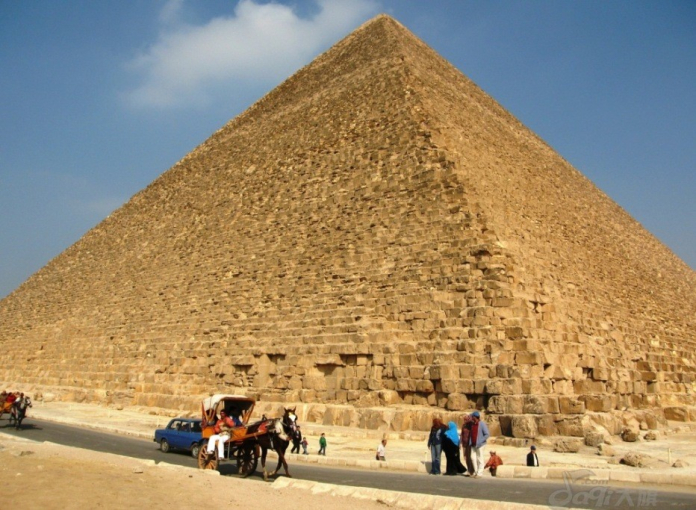
The Great Pyramid of Giza is the tomb of Pharaoh Khufu (approximately 2670 BC) of the Fourth Dynasty of Egypt. In ancient Egypt, each pharaoh began building his own tomb from the day he ascended to the throne, in order to achieve divinity after death.
The largest of the three pyramids, the Great Pyramid of Khufu, is an almost solid mass of limestone. It stands at a height of 146.59 meters with a base length of 230 meters and is made up of more than 2.5 million stone blocks. The outer layer consists of approximately 115,000 blocks, with an average weight of 2.5 tons per block and some weighing over 15 tons. If these blocks were carved into small cubes of one cubic foot each and placed end to end along the equator, the resulting line would be two-thirds the length of the equator.
4,700 years ago, with the passing of time, today's Great Pyramid of Giza no longer retains its former glory. The height of the pyramid is only 136.5 meters, and the length of the base has been shortened to 220 meters due to the loss of the outer layer of limestone. The original outer layer of polished white limestone that covered the pyramid has almost completely disappeared. What we see today are the light yellow limestone blocks underneath, revealing its internal structure.
The Great Pyramid of Giza has a slope angle of 51 degrees 52 minutes. The base of the pyramid is square, covering an area of 52,900 square meters. The entire pyramid was built on a huge convex rock, covering an area of about 52,900 square meters and with a volume of about 2.6 million cubic meters.
Next to the pyramid are small pyramids and rectangular tomb platforms belonging to members of the royal and noble families.
Khafre's Pyramid
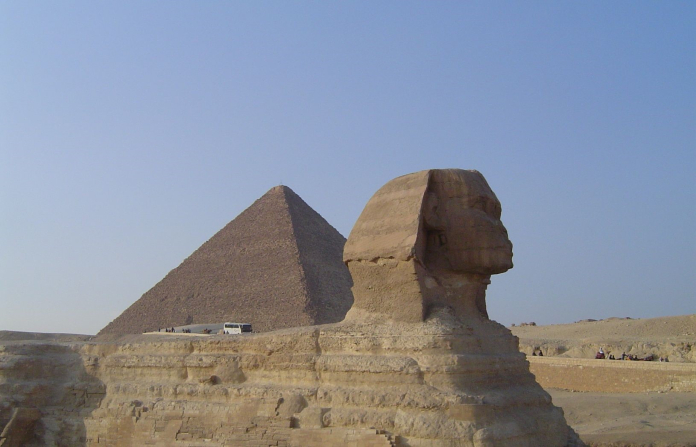
The Khafre Pyramid, which is 143.5 meters high, is the second largest pyramid in Egypt and the tomb of Pharaoh Khafre, the fourth ruler of the Fourth Dynasty of Ancient Egypt (approximately 2575 BC to 2465 BC). The famous Great Sphinx is located right next to the Khafre Pyramid, with its human face believed to be a likeness of Khafre. For a long time, due to the high humidity and poor ventilation inside the pyramid, cracks appeared on the walls of the burial chamber. In 1992, the Khafre Pyramid experienced a 5.4-magnitude earthquake, causing some damage. After more than two years of comprehensive repairs, it was reopened in July 2001.
Menkhaure Pyramid
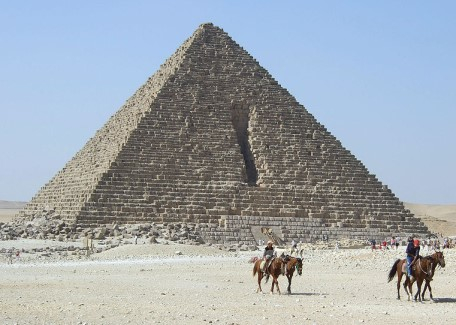
Menkaure, the successor of Pharaoh Khafre, also built a pyramid in Giza, which is much smaller than the two aforementioned pyramids. It was built around 2600 BC, during the decline of the Fourth Dynasty. The base is only 108 meters long and the height is only 67 meters, with an actual volume only one-tenth of the Great Pyramid.
The bottom sixteen layers of Menkaure's pyramid are covered in red granite, which was built in the 12th century BC and is still intact today. Its hardness is so great that even iron tools cannot scratch its surface, and the blocks fit together extremely tightly. Menkaure's pyramid consists of up to 230,000 to 260,000 blocks, which are heavier and more roughly cut than those used in other pyramids, and the internal structure is also more chaotic, possibly due to being built hastily.
The entrance of this pyramid is located on the north side and is a distance above the ground. Once inside, there is also a downward sloping passage at a 26-degree angle, leading straight into the dark underground. In some parts of the passage, it is rectangular and one must bend over to pass through.
The Legend of the Architectural Layout of the Giza Pyramids
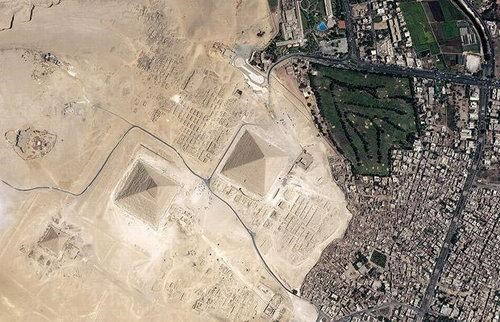
The three pyramids in Giza are located in a way that aligns with the Belt of Orion, and the positions of the Milky Way and Nile River are also symmetrically distributed. The Belt of Orion is significant to the Egyptians because they believed that the gods resided in the constellation, which represented heaven.
Around 2500 BC, four shafts were built, each pointing towards a specific star that was then crossing the meridian. These stars were the second star of the Little Dipper, the brightest star of Canis Major, the North Star, and the first star of Draco. However, the correspondence between the shafts and stars lasted only for about a century due to the astronomical phenomenon known as precession.
Sirius is an unusual star that has the status of a binary star system: Sirius A is what we see, while there is also Sirius B, which orbits around Sirius A but is too small to be seen with the naked eye.
It was not until 1862 that American astronomer Alvin Clark, using the largest and newest telescope of the time, discovered the existence of Sirius B. This was the first time that Westerners had seen Sirius B. However, the ancient Egyptians had already possessed the knowledge that Sirius was a binary star system.
To be continued.
Chinese version: https://big5.zhengjian.org/node/75984
